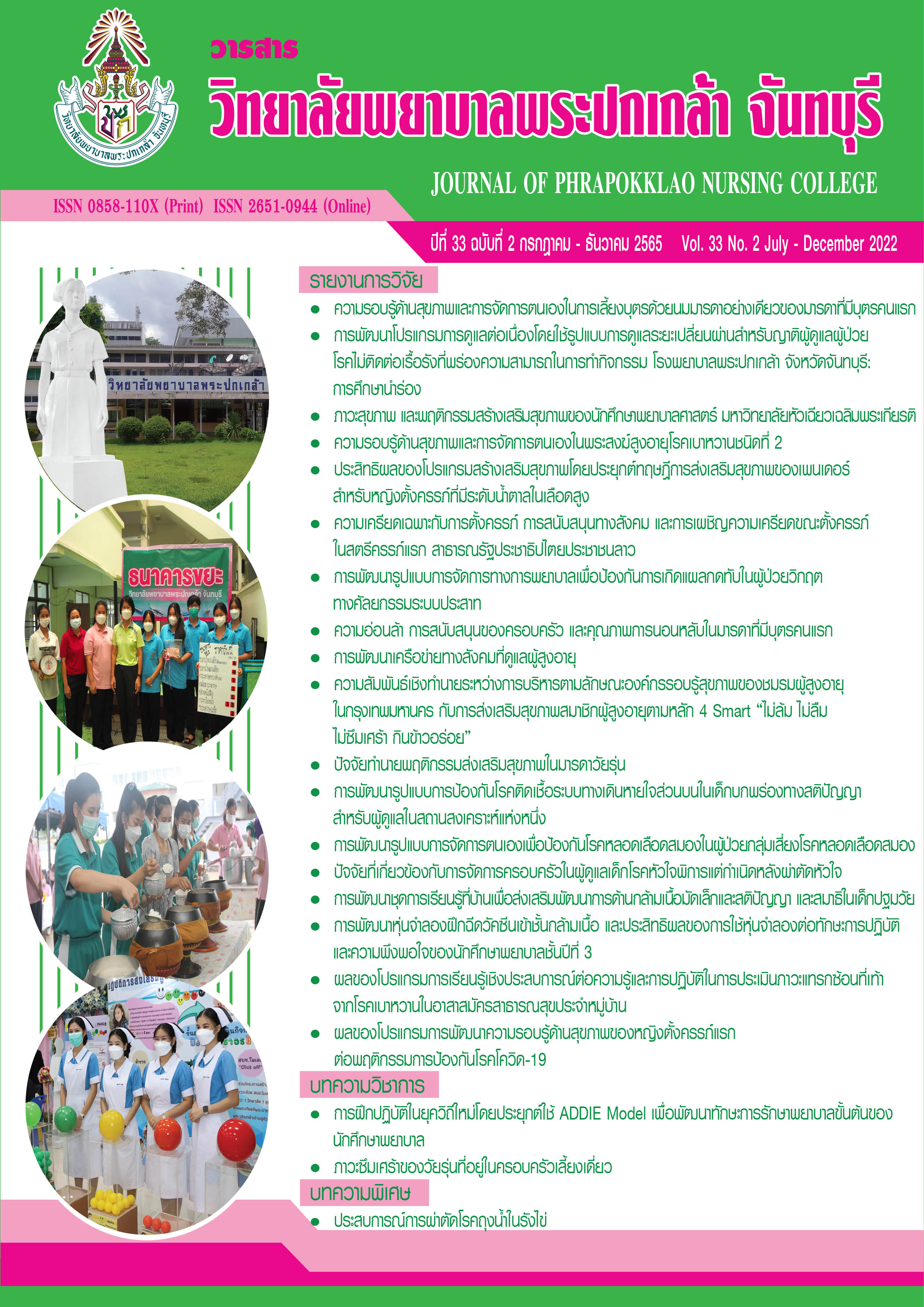Predictive Correlation between Administration According to Characteristic of Health Literacy Organization of Elderly Clubs in Bangkok and Elderly Members’ Health Promotion 4 Smart “Do not Fall, Do not Forget, Do not Depress, and Deliciously Eating”
Keywords:
Elderly club, Health promotion, Health literacy organizationAbstract
This predictive correlational research aimed to study the elderly members’ health promotion 4 smart “do not fall, do not forget, do not depress, and deliciously eating” and the predictive power of the administration according to characteristic of health literacy organization of elderly clubs on the elderly members’ health promotion 4 smart. The samples were 221 elderly clubs in Bangkok. The research instrument was a four-part questionnaire including: 1) general data of elderly clubs, 2) health activities organized by elderly clubs, 3) administration according to characteristic of health literacy organization with reliability of .96, and 4) elderly members’ health promotion 4 smart “do not fall, do not forget, do not depress, and deliciously eating” with reliability of .97. Data were collected from November, 2018 to January, 2019. Statistics used for data analysis included frequency, percentage, mean, standard deviation, and stepwise multiple regression analysis.
The research results revealed that 1) the elderly clubs had the total mean score of administration according to characteristic of health literacy organization at a moderate level (M = 2.23, SD = .41), 2) the elderly clubs had the mean score of elderly members’ health promotion 4 smart “do not fall, do not forget, do not depress, and deliciously eating” at a moderate level (M = 3.10, SD = 1.30), and 3) providing accessibility and transferring health information to members, communicating for rights protection, and being role model of club committees in disseminating health information were statistically significantly predicted the elderly members’ health promotion 4 smart at 32.70% (R2 = .327, p < .001).
This research suggests that health agencies should take the compositions of administration which could predict the elderly members’ health promotion to design a development plan for administrative skills of elderly club committee. This will help elderly clubs increase response to needs of the members.
References
กมลรัตน์ กิตติพิมพานนท์, และผจงจิต ไกรถาวร. (2558). ประสิทธิผลของรูปแบบการป้องกันการหกล้มที่ใช้ชุมชนเป็นฐานต่อสมรรถภาพทางกายและการพลัดตกหกล้มของผู้สูงอายุที่อาศัยอยู่ในชุมชนเมือง กรุงเทพมหานคร: การศึกษาติดตามผล. วารสารพยาบาลสาธารณสุข, 29(1), 98–113.
กรมกิจการผู้สูงอายุ. (2563). ข้อมูลสถิติจำนวนผู้สูงอายุประเทศไทย ปี 2561 ด้วยระบบ Power Bi / pdf. สืบค้นจาก https://www.dop.go.th/th/know/1/153
กรมอนามัย กระทรวงสาธารณสุข. (2562). กรมอนามัย ห่วงสุขภาพผู้สูงวัย แนะใช้หลัก ‘ไม่ล้ม ไม่ลืม ไม่ซึมเศร้า กินข้าวอร่อย’. สืบค้นจาก https://multimedia.anamai.moph.go.th/news/news04042562/
กองยุทธศาสตร์สาธารณสุขและสิ่งแวดล้อม. (2562). รายงานข้อมูลผู้สูงอายุของกรุงเทพมหานครจากฐานประชากรในระบบทะเบียนราษฎร ณ เดือนธันวาคม 2561 และเปรียบเทียบกับข้อมูล ณ เดือนธันวาคม 2560. สืบค้นจาก https://webportal.bangkok.go.th/upload/user/00000132/download/22_02_62fullpaper.pdf
กานดาวสี มาลีวงษ์, วนิดา ดุรงค์ฤทธิชัย, ยงยศ หัตถพรสวรรค์, ศรีสุดา สว่างสาลี, วณิดา มงคลสินธุ์, ภุชงค์ เสนานุช, สุวิมล แสนเวียงจันทร์, และสมศักดิ์ อมรสิริพงศ์. (2561). ความรอบรู้สุขภาพของชมรมผู้สูงอายุเพื่อส่งเสริมสุขภาพผู้สูงอายุ “ไม่ล้ม ไม่ลืม ไม่ซึมเศร้า กินข้าวอร่อย”: กรณีศึกษาเขตดอนเมือง. วารสารเกื้อการุณย์, 25(2), 119–136.
กิจปพน ศรีธานี. (2560). ความสัมพันธ์ระหว่างความฉลาดทางสุขภาพกับคุณภาพชีวิตของผู้สูงอายุในภาคตะวันออกเฉียงเหนือตอนกลาง. วารสารวิจัยระบบสาธารณสุข, 11(1), 26–36.
จุฑาพร คํามณี. (2558). ปัจจัยที่ทำให้ชมรมผู้สูงอายุประสบความสำเร็จสู่การเป็นชมรมที่เข้มแข็ง (สารนิพนธ์ปริญญามหาบัณฑิต). กรุงเทพฯ: มหาวิทยาลัยธรรมศาสตร์.
ชนนิพัทธ์ ประเสริฐพรรณ, นพวรรณ เปียซื่อ, สุจินดา จารุพัฒน์ มารุโอ, และกมลรัตน์ กิตติพิมพานนท์. (2557). กิจกรรมและผลการดำเนินกิจกรรมของชมรมผู้สูงอายุในชุมชนเมือง: กรณีศึกษา. รามาธิบดีพยาบาลสาร, 20(3), 388–400.
ชะนวนทอง ธนสุกาญจน์, วิมล โรมา, และมุกดา สำนวนกลาง. (2561). แนวคิด หลักการขององค์กรรอบรู้ด้านสุขภาพ. สืบค้นจาก http://203.157.71.139/group_sr/allfile/1578714596.pdf
ธัญฑิญา ทรงวุฒิ, วิราสิริริ์ วสีวีรสิว์, และสุธรรม นันทมงคลชัย. (ม.ป.ป.). บทบาทของคณะกรรมการในการดำเนินงานชมรมผู้สูงอายุ จังหวัดอุตรดิตถ์. สืบค้นจาก https://oldweb.western.ac.th/images/HealthK/Research/A.Role.pdf
ธัญยรัชต์ องค์มีเกียรติ. (2561). ภาวะเปราะบางในผู้สูงอายุ: กรณีศึกษา. วารสารสภาการพยาบาล, 33(3), 5–19.
นิพา ศรีช้าง, และลวิตรา ก๋าวี. (ม.ป.ป.). รายงานการพยากรณ์การพลัดตกหกล้มของผู้สูงอายุ (อายุ 60 ปีขึ้นไป) ในประเทศไทย ปี พ.ศ. 2560–2564. สืบค้นจาก http://www.thaincd.com/document/file/violence/การพยากรณ์การพลัดตกหกล้มในผู้สูงอายุ%20ปี%202560-2564.pdf
นิรัชรา ศศิธร. (2557). ภาวะซึมเศร้า และปัจจัยทางจิตสังคมที่เกี่ยวข้อง ของผู้สูงอายุในชมรมผู้สูงอายุ สังกัดศูนย์บริการสาธารณสุข 48 นาควัชระอุทิศ (วิทยานิพนธ์ปริญญามหาบัณฑิต). กรุงเทพฯ: จุฬาลงกรณ์มหาวิทยาลัย.
บรรลุ ศิริพานิช. (2559). สถานการณ์ผู้สูงอายุไทย พ.ศ. 2559. สืบค้นจาก http://www.dop.go.th/download/knowledge/th1512367202-108_0.pdf
ปาจรีย์ ผลประเสริฐ, และวรางคณา จันทร์คง. (2561). บริหารจัดการชมรมผู้สูงอายุ อย่างไรให้สำเร็จ?. วารสารชุมชนวิจัย, 12(2), 26–36.
ปิติพร สิริทิพากร. (2557). บทบาทพยาบาลในการดูแลผู้สูงอายุที่มีภาวะสมองเสื่อมและผู้ดูแล. วารสารพยาบาล, 63(4), 12–19.
ภาวิน ทองไชย. (2556). สุขภาพจิตและการดูแลตนเองของผู้สูงอายุในชมรมผู้สูงอายุ เขตคลองสาน กรุงเทพมหานคร (วิทยานิพนธ์ปริญญามหาบัณฑิต). กรุงเทพฯ: จุฬาลงกรณ์มหาวิทยาลัย.
วิทยาลัยการจัดการ มหาวิทยาลัยมหิดล. (2561). งานวิจัย AWUSO Society 4.0 แก่แต่วัย หัวใจยังเก๋า. สืบค้นจาก http://www.cmmu.mahidol.ac.th/cmmu/index.php/9-college-news/540-awuso-society-4-0
วิทยาลัยประชากรศาสตร์ จุฬาลงกรณ์มหาวิทยาลัย. (2560). แผนพัฒนาคุณภาพชีวิตผู้สูงอายุกรุงเทพมหานคร ระยะที่ 2 (พ.ศ. 2561–2564). สืบค้นจาก https://webportal.bangkok.go.th/upload/user/00000132/download/AgingPlan_II.pdf
วิมล โรมา. (2561). แนวทางการพัฒนาสู่องค์กรรอบรู้ด้านสุขภาพ (HLO) ของสถาบันพัฒนาอนามัยเด็กแห่งชาติ. สืบค้นจาก http://dohhl.anamai.moph.go.th/download/2561/HLO%2011.1.61.pdf
วีรพล กิตติพิบูลย์, และนิธิรัตน์ บุญตานนท์. (2563). การพัฒนารูปแบบการคัดกรองและส่งเสริมสุขภาวะเพื่อป้องกันการเข้าสู่ภาวะพึ่งพิงของผู้สูงอายุตามแนวคิด “ไม่ล้ม ไม่ลืม ไม่ซึมเศร้า กินข้าวอร่อย”. วารสารศูนย์อนามัยที่ 9, 14(34), 158–171.
ศิรินภา ฉัตรเงิน, อุไรวรรณ ชัยชนะวิโรจน์, และอุมาพร ห่านรุ่งชโรทร. (2561). ปัจจัยที่มีอิทธิพลต่อพฤติกรรมลดความเสี่ยงต่อการเกิดภาวะสมองเสื่อมในผู้สูงอายุในเขตกรุงเทพมหานคร. วารสารวิทยาลัยพยาบาลบรมราชชนนี กรุงเทพ, 34(1), 81–90.
สมฤทัย บุญสุธากุล. (ม.ป.ป.). ฐานข้อมูลทางวิชาการด้านการดูแลรักษาพยาบาลผู้สูงอายุแบบครบวงจรเพื่อสนับสนุนการดำเนินงานของคณะกรรมาธิการการสาธารณสุข. สืบค้นจาก https://www.senate.go.th/assets/portals/28/fileups/146/files/ฐานข้อมูลทางวิชาการ.pdf
สมาคมสภาผู้สูงอายุแห่งประเทศไทยฯ. (ม.ป.ป.). คู่มือชมรมผู้สูงอายุ. สืบค้นจาก http://www.dop.go.th/download/knowledge/knowledge_th_20161706104732_1.pdf
อนันต์ อนันตกูล. (ม.ป.ป.). สังคมสูงวัย...ความท้าทายประเทศไทย. สืบค้นจาก https://tinyurl.com/mr3v73k5
Brach, C., Keller, D., Hernandez, L. M., Baur, C., Parker, R., Dreyer, B., Schyve, P., Lemerise, A. J., & Schillinger, D. (2012). Ten attributes of health literate health care organizations. Retrieved from https://nam.edu/wp-content/uploads/2015/06/BPH_Ten_HLit_Attributes.pdf
Carneiro, J. A., Cardoso, R. R., Durães, M. S., Guedes, M. C. A., Santos, F. L., Costa, F. M. D., & Caldeira, A. P. (2017). Frailty in the elderly: Prevalence and associated factors. Revista Brasileira de Enfermagem, 70(4), 747–752. doi:10.1590/0034-7167-2016-0633
Ezebuihe, I., & Sigley, C. (2016). Health literacy: Concept analysis. International Journal of Healthcare Sciences, 4(2), 55–62. Retrieved from https://www.researchpublish.com/upload/book/HEALTH%20LITERACY%20CONCEPT%20ANALYSIS-3764.pdf
Huitt, W. (2007). Maslow’s hierarchy of needs. Retrieved from http://www.edpsycinteractive.org/topics/conation/maslow.html
Krejcie, R. V., & Morgan, D. W. (1970). Determining sample size for research activities. Educational and Psychological Measurement, 30(3), 607–610. Retrieved from https://doi.org/10.1177/001316447003000308
McMichael, A. J., & Butler, C. D. (2006). Emerging health issues: The widening challenge for population health promotion. Health Promotion International, 21(Suppl. 1), 15–24. doi:10.1093/heapro/dal047
Palumbo, R. (2016). Designing health-literate health care organization: A literature review. Health Services Management Research, 29(3), 79–87. doi:10.1177/0951484816639741
Thomas, J. (Ed.). (2017). Ageing: Learning from the global south. Dhaka, Bangladesh: Partners in Population and Development.
Winstead, V., Yost, E. A., Cotten, S. R., Berkowsky, R. W., & Anderson, W. A. (2014). The impact of activity interventions on the well-being of older adults in continuing care communities. Journal of Applied Gerontology, 33(7), 888–911. doi:10.1177/0733464814537701
World Health Organization. (2013). Health literacy: The solid facts. Copenhagen, Denmark: WHO Regional Office for Europe.
Wright, A. (2017). What’s so important about health policy implementation?. Retrieved from https://www.researchgate.net/publication/320101578_What's_so_important_about_health_policy_implementation
Downloads
Published
How to Cite
Issue
Section
License
Copyright (c) 2022 JOURNAL OF PHRAPOKKLAO NURSING COLLEGE

This work is licensed under a Creative Commons Attribution-NonCommercial-NoDerivatives 4.0 International License.
เนื้อความ ข้อมูล และรายการอ้างอิงที่ผู้เขียนใช้ในการเขียนบทความเพื่อลงตีพิมพ์ในวารสารวิทยาลัยพยาบาลพระปกเกล้า จันทบุรี ถือเป็นความคิดเห็นและความรับผิดชอบของผู้เขียน คณะผู้จัดทำวารสารไม่จำเป็นต้องเห็นพ้องด้วยหรือร่วมรับผิดชอบ
บทความที่ได้รับการลงตีพิมพ์ในวารสารวิทยาลัยพยาบาลพระปกเกล้า จันทบุรี ถือเป็นลิขสิทธิ์ของวารสารวิทยาลัยพยาบาลพระปกเกล้า จันทบุรี หากหน่วยงานหรือบุคคลใดต้องการนำส่วนหนึ่งหรือทั้งหมดของบทความไปเผยแพร่ต่อเพื่อวัตถุประสงค์ใด ๆ จะต้องได้รับอนุญาตจากบรรณาธิการวารสารก่อน



